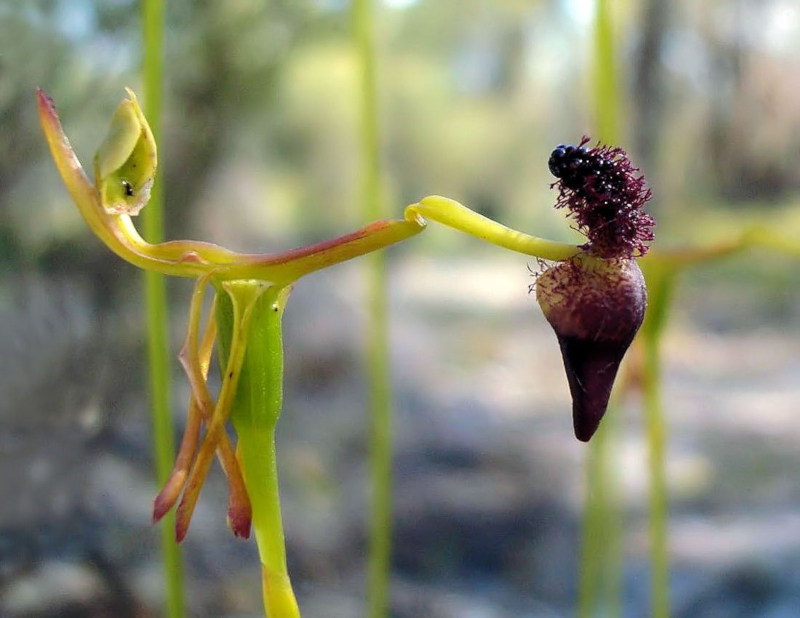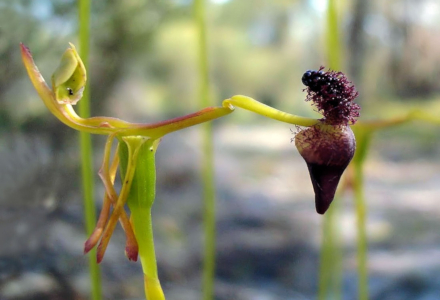
Hammer Orchid Facts
- It bears pointing out that the term Hammer Orchid actually serves as the collective common name for an entire genus of plants. Furthermore, that truly remarkable genus, named Drakaea, contains a total of ten extremely beautiful species of orchids.
- Quite understandably, all ten of these fascinating varieties remain extremely similar in terms of general appearance. Remarkably, the first member of this amazing group of flowers was officially recognized in modern times. That occurred in 1840.
- The noted English botanist, John Lindley made this first formal identification. The distinctive common name derives from the unique shape of a part of the flower, in addition to the manner in which it moves during the process of pollination.
- Unfortunately, a total of five of the various plants known by the term Hammer Orchid appear on the IUCN Red List of Threatened Species. Currently, the various members of the genus on the list also hold the status of either Threatened or Endangered.
- The local government of the area in which these appear classifies them own in its own way, too. There, the plants list as Priority One, on its own scale. That same local government also considers that each member of the genus needs special protection.
- The greatest threats these flora faced previously included habitat loss, along with the decline of an insect species they depend on. However, the threat of climate change now looms over them, as it does many species around the world today.
Related Articles
Hammer Orchid Physical Description
Since the term Hammer Orchid applies to a total of ten different species, certain physical differences understandably occur. The members of the genus nevertheless remain extremely similar in terms of physical characteristics. Variations are relatively minor.
In fact, the physical resemblance between them remains so strong that to the untrained eye they may appear completely identical to each other. The greatest difference between the various members of the incredible genus remains the sheer height of the delicate stems.
That’s due to the fact that, between the ten different types, the stem ranges in height from about 8 – 12 in (20. 3 – 30.5 cm). For the rest of the various parts of the differing types of plants, these continue to be nearly identical in appearance to the untrained eye.
The distinct physical characteristics of the Hammer Orchid include the presence of a single, thumbnail-sized leaf. This unique foliage typically hugs the ground. The stem itself also bears a bract resembling a leaf. This appears just below the halfway point of the stem.
A single delicate flower develops at the apex of the stem of the members of this group. The labellum most commonly manifests a dark, purplish color. Meanwhile, the petals of the plants tend to vary slightly in color, but usually appear in various shades of pink.
- Kingdom: Plantae
- Phylum: Angiosperms
- Class: Monocots
- Order: Asparagales
- Family: Orchidaceae
- Genus: Drakaea
Hammer Orchid Distribution, Habitat, and Ecology
Not surprisingly, all ten of the different species within the genus known collectively as the Hammer Orchid live in a warm climate. All ten of these astounding flowers also live within a comparatively small range. That’s a specific section of the continent of Australia.
Even more specifically, though, they appear only in the southwest portion of the country. This tiny area comprises the botanical province, between the Geraldton and Esperance provinces. It’s unknown if any of them ever appeared anywhere outside of this range.
All of the forms of this unique and fascinating orchid live in almost identical habitats. Unlike most varieties of orchid, these flowers commonly appear in regions consisting of loose, sandy soil. They also often appear in the immediate vicinity of granite rocks.
Each of the members of the wonderful genus, together known as the Hammer Orchid, evolved a highly specialized nature. This indicates a close evolutionary path. In this case, each developed an extremely close relationship with wasps in the Thynnidae family.
In most cases, each of the species achieves its pollination through the activities of a single, different species of wasp in this family. A few do share pollinators with other orchids. The relationship between the wasps and the plants additionally remains complex.
The male carries the female to a food source, typically one of the members of this genus. Due to the evolution of these flowers, the labellum resembles the female wasp in shape, and even in scent. Pollination occurs when the male attempts to carry of the labellum.
Species Sharing Its Range
Check out our other articles on 5 Rare Mind-Blowing Cloud Types, Indian Bullfrog, Eye of the Sahara, Chatham Island forget-me-not, Red Crested Tree Rat, Mitchell’s Satyr Butterfly

